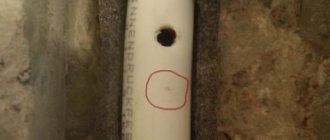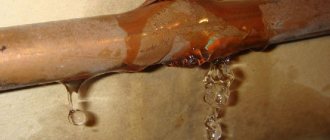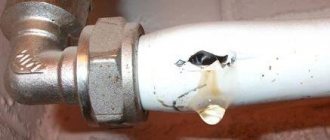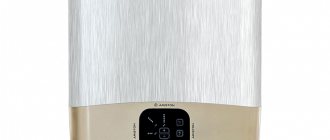How to seal the junction of the pipe to the slate roof?
An asbestos cement pipe extends three meters from a hole in the roof slate. Wind, humidity, and vibration cause cracks in the seal around the cement mortar pipe.
Any cement-based products will crack sooner or later. If the pipe does not heat up very much (up to 200-300 C), it is better to use complex grout. First, treat the joint with a special sealant for hot temperatures, and then apply a cement seal. If the pipe gets very hot, you can buy rubberized nozzles. But they have a minus - after a few years in the sun they also begin to crack and leak.
Until recently, I never thought that I would encounter such a problem, until, as people say, “the rooster pecked.” This time we will try to consider simple options, without additional investments. I offer my own version, which I had to do myself.
To do this, it is enough to have at home or buy aluminum foil for baking, such as Sayana.
First, we seal around the pipe with mortar, asbestos or alabaster (gypsum), and it’s okay that it will crack over time. The main thing is to carefully wrap aluminum foil around the pipe and secure it with a simple clamp or wire, then again apply a small layer of solution around it so that the foil does not tear, and then put a decorative flange on the pipe. That's all.
Alternatively, you need to use a round penetration made of silicone or membrane rubber. Actually, these materials, due to their elasticity, can create sufficient waterproofing and can be used on various roofing materials, including slate roofing (note that the diameter of the penetration is taken to be approximately 20 percent smaller than the diameter of the pipe). Of course, in your case there will be some “inconvenience” associated with the presence of high waves in the slate, and if using only the penetration is impossible, then you can use an apron, the main thing here is to adhere to the basic canons of installing pipes on the roof (including “setting up” the apron either under the ridge or under the top sheet of slate). Only then can you use a silicone or rubber penetration. I think that this is the best option, since you are writing about the problem of vibration of a high pipe and its negative impact on the slate itself from this. In the option I propose, this effect is eliminated, since the tightness of the pipe is not achieved by “monolithic” insulation. The pictures actually show the principle of sealing seams:
Let's decide on the materials
The main salvation for slate is asbestos fabric soaked in properly prepared tile adhesive. This method is considered the simplest and most accessible, since it requires virtually no financial costs. Standard tile adhesive and asbestos fabric are widely available and inexpensive, which makes this method a priority.
Other materials are also great for slate repair:
- Coating mixtures based on polymers and cement. They are sold in construction stores in finished form, for convenience they are packaged in plastic buckets and small jars. Dry mixtures are packaged in paper bags.
- Sealants. Epoxy resin, polyurethane foam and silicone sealant that are resistant to high temperatures are suitable for repairing slate.
- Hot bitumen mastic. A traditional slate repair method that has been used for years. By covering the roof with several layers, you can forget about leaks for many years.
- Butyl rubber tape. Very easy to use because it has an adhesive layer on the back.
- Cement-sand mixture. Another budget method for slate repair. Most often used for repairing roofing materials with a rough surface, due to increased requirements for adhesion.
Bitumen-rubber self-adhesive sealing tape
Despite the fact that there are many materials for restoring a slate roof and sealing the joint between the covering and the chimney, the advice for all methods is the same - you need to start with processing. To achieve excellent adhesion between the slate and the above materials, the surface should be degreased with gasoline, cleaned of small debris, removed moss and all kinds of vegetation, and, possibly, replaced broken fragments of slate, since sooner or later they will become unusable again.
Consequences of an unsealed joint
To bring the chimney through the roof, a larger diameter is cut out into it, so that a gap remains between the walls of the chimney and the roofing material. Regardless of the width of the gap, it is a big problem faced by homeowners and builders. To eliminate this defect and protect the under-roof space from the penetration of atmospheric moisture, use seals, aprons, collars, made by yourself or purchased. An unsealed gap between the roof and the chimney pipe is fraught with the following consequences:
- Increased wear of roofing material. Most roof waterproofing materials offer better protection against moisture penetration from the outside. Moisture penetrating through an unsealed gap gets onto the inner surface of the roof and eventually destroys it.
- Reducing the service life of the rafter frame. The pouring water hits the elements of the rafter frame, which are made of wood. This leads to rotting and premature destruction of the rafters.
- Reduced insulation efficiency. Roof insulation materials lose their properties when wet, becoming less effective.
- Increased humidity in the attic. Increased dampness in the attic causes heavy, stale air and negatively affects the interior decoration of the room.
Important! The method of sealing the gap between the chimney and the roof depends on its size, the type of roofing material used and the shape of the chimney. If the distance is less than 5 mm, it is quite possible to get by with a heat-resistant silicone-based sealant. You can close a gap whose width is 1 cm or more using cement mortar, an apron, or a special sealant.
How to seal a chimney on a slate roof
Bringing a pipe or ventilation shaft through the roof involves making a hole in it. When a pipe passes through, there always remains a gap, which, even at its lowest value, will allow moisture to pass through. Today we’ll look at how to achieve perfect tightness at the junction of the pipe and the roof and how to seal the resulting gap between the pipe and the roof.
Sealing with mortar
To seal the gap between the chimney pipe and the slate or tile roof, use moisture-resistant cement mortar and a decorative collar. This is the most affordable way to insulate the attic and rafters from moisture with your own hands. This requires dry mortar, water, a mixing container, steel corners and a collar. Installation work is carried out in the following order:
- The gap between the roof and the outer wall of the pipe is lined with stainless steel corners. If the chimney is oval or round in shape, you can use a rubber seal with an adhesive backing.
- A decorative collar made of galvanized steel is put over the chimney head and secured with self-tapping screws.
- A pre-mixed viscous solution is poured into the gap between the collar and the pipe and allowed to harden for 1 day.
- After a day, check the quality of the filling and the degree of hardening of the solution. A surface for liquid drainage is made from a sheet of sheet steel. To do this, a hole is cut out in it, the diameter of which corresponds to the size of the collar, put on the head and fixed with self-tapping screws.
Important! To ensure that the structure is reliable and does not collapse during the first serious downpour, high-quality waterproof cement is used. Otherwise, cracks will appear on it, through which water will leak into the rafter frame.
What happens if you leave the bayonet unfixed?
There will always be a gap between the chimney and the slate. It cannot be otherwise. Another thing is its size. Gaps can be significant or small. If they are too large, then the residents of such a house may have problems. It is to prevent moisture from penetrating under the roof or into the room that structures such as decorative aprons and collars and other seals are used, which can either be purchased or made at home.
If you do not seal the cracks, the following troubles may occur:
- The roof covering will wear out quickly. This is due to the fact that almost all materials that were used for roof waterproofing are coated with protective compounds on the outside, thereby being negatively affected by excessive humidity from the inside. The ingress of water leads to premature destruction of the material and, as a result, complete covering of the roof.
- Reducing the service life of the rafter frame. The rafters are made of wood. As soon as moisture gets on the tree, the process of rotting and its rapid destruction begins.
- Reduced efficiency of insulation material. Absolutely all materials used for roof insulation are water-resistant. When wet, they lose their basic properties, becoming unsuitable for further use for their intended purpose.
- Increased humidity level in the attic. When water gets inside the attic, it causes the air to become heavy and stale. This negatively affects the interior decoration of the room.
Sealing with a steel apron
To seal the gap between the chimney pipe and the roofing material with your own hands on roofs made of metal tiles and corrugated sheets, use special aprons. They are made of galvanized steel in the color of the roof in the form of additional elements. With their help, you can reliably and aesthetically isolate the gap; to do this, proceed in the following order:
- Along the perimeter of the pipe, strips of waterproofing 30 cm wide are laid, bringing the edges up, fixing them on the wall with sealant or adhesive tape.
- To close the gap at the chimney outlet, metal wall profiles are used. The lower fastening flange is tucked under the roofing material and fixed to the rafters with silicone sealant with a moisture-resistant composition. The top shelf is attached to the pipe wall.
- Decorative textures are installed from galvanized steel with a polymer coating. It is a set of additional elements that are overlapped with each other and secured with self-tapping screws to the pipe and roofing material.
Important! You can make your own apron from sheet steel. However, factory products look more aesthetically pleasing and presentable. When working on the roof, special roofing screws are used as fasteners, equipped with a rubber headband, which, when twisted, flattens, closing the hole from water penetration. If there are no such screws at hand, gaskets are cut out of rubber using them with ordinary self-tapping screws.
We eliminate gaps in other types of roofing
Not only owners of houses with slate roofs face a similar problem. A gap often occurs in other types of coating, and this can be caused by a variety of factors:
- shrinkage of the house;
- mechanical damage;
- improper, careless installation of the roof.
There are various methods available to help restore the integrity of your roof and protect your attic from leaks. To do this, you need to build on the type of roofing.
Tile roof
Tile is a strong, durable and beautiful material, so an asbestos patch disrupts the aesthetics and spoils the appearance of the roof. In this case, it is recommended to use a mixture of sand and cement. Surprisingly, it is suitable in this case, since the rough structure of the tiles contributes to excellent adhesion.
To make the patch look aesthetically pleasing, it is recommended to make a galvanized collar, which is subsequently filled with a properly prepared mixture. Excess solution should flow down improvised gutters so that unsightly smudges do not form on the pipe.
Bitumen roof
Soft tiles (made from a bitumen mixture) are an excellent roofing material. To close gaps use:
- "Wakaflex" tape;
- bitumen mastic.
Tape for sealing joints Wakaflex
The tape provides reliable waterproofing and a tight transition from one plane to another, and bitumen mastic provides excellent adhesion.
Corrugated roof
In the case of corrugated sheets, everything is still much easier and faster. You can seal the joint with silicone sealant. By filling the cartridge into the gun, you can create a thick, uniform layer that fills the entire hole. Several repeated layers will help seal the hole tightly. To ensure that the seam comes out neat and with beautiful, even edges, you can use masking tape.
As you can see, cracked and peeling slate is not a reason to replace the entire roof. With these methods, you can restore the coating, and it will last for several decades, and you will not worry about leaks. Don’t forget to share your opinion about these methods in the comments, because other readers will be very interested in your experience.
Sealing with rubber aprons
Construction stores suggest using Master Flash rubber aprons or Wakaflex sealing tapes to seal gaps where pipes pass through a roof made of any material:
- Master Flash is an elastic penetration on a rubber base in the form of a stepped funnel, reinforced with aluminum mesh inside. It is suitable for roofs with any slope and any roofing material. The rubber apron reliably protects the gap from liquid penetration. To adjust the apron to the size of the pipe, it is cut to the required diameter. The apron is fixed to the slope with self-tapping screws, and to the pipe using a steel clamp.
Note! To eliminate large gaps, a fiber sealant is first compacted into them, and then filled with bitumen mastic or filled with foam. After this, the passage area is decorated with a decorative collar. Please note that collars are produced with a standard angle, which is selected in accordance with the slope of the roof slope and the diameter of the chimney.
The main condition for long-term operation of the roof is maximum tightness, which is achieved by isolating even minor gaps. Whatever sealing method you choose, remember that reliable protection against moisture penetration is more important than an attractive appearance.
Can you imagine a house without a roof? Sounds crazy. And it’s true, not a single building can do without a roof. It plays the role of a protector from heavenly precipitation and keeps the house warm. The functionality of the roof depends on the quality of its execution. That is why at the construction stage it is important to follow the rules for the manufacture of roofs, so that later you do not have to finish or redo anything.
How to fill holes in slate and cracks
Before carrying out any repair work, it is first necessary to clean the surface of debris and moss, and then rinse it with a strong stream of water. In order to decide what to use to repair holes and other damage, you need to consider the materials suitable for this task and the method of their use in more detail to clarify the main features.
Concrete mortar
One of the most affordable solutions with which you can seal holes of any size. The preparation of concrete mortar should be made from dry cement and sifted sand in a ratio of 1:2, which must be filled with water and mixed thoroughly until the mixture is given the required consistency.
The materials are inexpensive and preparing a composition from them does not take much time.
To carry out repair work, it is necessary to prepare a wooden formwork box, which can be built in the shape of a ring from the tread strip of an old car inner tube. Next, the area that has been damaged or has a hole must be carefully cut to size so that the made frame can be placed under the slate and fixed.
Then you need to pour the concrete mortar and lay a patch from a larger piece of slate sheet over the hole. In some cases, the edges of such a patch are painted with oil or rubber paint.
Waterproof Butyl Rubber Tape
It is used extremely often due to its high elasticity, thanks to which it is possible to seal almost any crack, not only on slate, but even on water pipes or balcony glass.
The tape is produced in rolls that resemble scotch tape, but unlike them, products based on butyl rubber have a more significant strength and a high degree of adhesion. Cracks that form on slate can be easily eliminated with its use, devoting a small amount of time to this.
Due to the fact that butyl rubber tape is made of non-woven material, if necessary, a patch made from it can be easily painted in the required color. Its use itself must be done as follows:
- Initially, before repairing, the slate section must be treated with gasoline to degrease.
- Next, you need to cut a piece of tape of optimal length, remove the protective shell and glue it to the damaged area. In this way, several layers should be applied.
- After this, you can paint it so that the repaired area does not stand out against the general background.
Under suitable conditions, the area to be pasted must be coated with acrylic paint or any nitro adhesive. Butyl rubber adheres to a smooth surface easily, unlike a rough coating made of asbestos cement, from which the tape can peel off when the first precipitation falls, which is why the edges of the crack must be opened with a paint mixture before gluing it.
In addition, ready-made butyl patches are used to patch holes and cracks, as well as serpyanka, which gives the putty joint of the sheets additional strength. To do this, the damaged area must first be treated with a layer of bitumen, then glued with serpyanka, and then the area must be covered again with bitumen.
Homemade and ready-made bitumen mastic
Before the sale of adhesive and polymer materials intended for repair, bitumen and roofing felt were used in many cases to eliminate all such damage to slate roofing. Bituminous mastics are not the highest quality option, but they are still often preferred today, since they are easy to use, inexpensive and do not require special preparatory measures before applying them.
If you have to prepare the mixture yourself, then the actions must be carried out in the following sequence:
- Go outside and light a fire, and then place two bricks on its sides.
- You need to take an old bucket and put a piece of bitumen in it.
- Next, the product should be placed on the fire and its contents should be stirred to avoid fire.
When performing work at temperatures below 0°C, 10% waste must be added to the bitumen to give the composition greater elasticity and to eliminate the possibility of cracks forming in the mastic.
Important! It is better to repair slate using ready-made liquid mastics based on bitumen.
When melting resins and this material, which is in a solid state, extreme care must be taken, since when heated, slate can not only increase in size, but also split.
Using bitumen mastic it is convenient to apply repair patches. To seal the resulting hole in the slate on the roof surface, you need to perform the following steps:
- Initially, it is necessary to cut out a rectangular patch from a sheet of repair slate.
- Next, you need to process the edges of the hole on the roof, and open the surface of the patch from the inside with a primer and one layer of mastic.
- After the prepared materials have dried, bitumen waterproofing should be reapplied and a patch should be laid in the area of the hole.
If the angle of inclination of the slope is sufficiently large, the slate patch must be secured to the roof surface or a nearby support using wire. After a few days, the seams should be treated with mastic again. Using this mixture and small pieces of slate, you can also quite easily remove excess nail holes in the roofing material, but in this case the work needs to be done from the inside out before installing it on the roof of the house.
Note! Repairing damage using various putties helps only for some time. The disadvantage in this case is that slate has little flexibility to expand, and these compositions have a completely different coefficient. For this reason, after several cycles of temperature changes, leaks reappear in the repaired areas, making it much easier and more reliable to replace the damaged sheet.
Cement-asbestos mortar with PVA
Using asbestos and cement, sealing holes on a slate roof is the most optimal relative to the structure of the roofing material, but this method is not only outdated, but also unsafe, since during the work it is necessary to interact with chrysotile fiber.
Even so, this option is very popular today, since it has no analogues that can provide the same long period of operation after application.
The asbestos-cement mixture must be prepared as follows:
- The first step is to take ready-made asbestos. If you were unable to purchase one, you should grate a piece of slate using a grater.
Note! When carrying out work, it is mandatory to ensure respiratory tract protection by wearing a respirator.
- Next, you need to take a metal container, for example, a galvanized bucket, in which you need to pre-soak the asbestos fiber for at least 24 hours. For 5 liters of water you should take 3-4 kg of material. After a day, the fiber takes on the appearance of a gel-like substance.
- About 2-3 kg of grade 400 cement must be added to the resulting asbestos mixture. The ratio between them should be 3:2.
- After this, you need to add a separately made composition of PVA glue and water in equal proportions. After mixing, the final result should be the consistency of sour cream.
After this, the solution is ready for use. Before application, it is only important to clean and dry the surface. Covering cracks and holes in slate with a mixture is quite easy to do, for which you just need to treat the damaged areas with a small amount and cover it with a composition of PVA and water in proportions 1:3. After this, the damaged areas need to be sealed with two more layers of mortar.
Upon completion, all areas undergoing repairs should be covered for several days with a film that will protect the composition applied to the roof from wind and precipitation until it completely hardens. After drying, the mixture takes on the appearance of a patch, which in its properties resembles slate. It is for this reason that asbestos cement is used when carrying out repair work on roofs that have significant damage.
Moisture resistant nitrocellulose glue
It is optimal to give preference to it when there is a need to seal cracks that have formed on the surface of the sheets directly above the wooden plank of the frame. Using a high-quality adhesive composition, it is possible to repair damage to slate faster and at lower cost compared to more expensive butyl rubber. For repair work, the glue should be divided in two:
- The first half must be diluted with acetone to a liquid state.
- The remaining part requires the addition of shavings and slate dust, which can be obtained by cutting the roofing material using a grinder.
The liquid composition should be used to open the crack several times, dry it and apply a thick mixture to the damaged area, and then stick a piece of construction tape. In a similar way, you can repair all defects in slate sheets on the roof, if their dimensions are no more than a few centimeters.
Polyurethane foam and epoxy resin
Using construction polyurethane foam, it is quite easy to repair various damage, including holes. If, due to careless handling, through breaks or even more so holes occur, then with this composition you can quickly and firmly fix a piece of slate of almost any size.
The foam is extremely easy to use. The hole or damaged area with a large crack should be moistened with water from the outside of the roof, as well as in the space under the roofing material. After this, it is necessary to apply the required amount of the mixture from the underside of the slate so that the resulting foam coating secures the sides of the hole. After 30 minutes, you can secure the repaired area with a patch. Polyurethane can also be used as an adhesive.
Note! Epoxy resin is a more suitable means for repairing slate, since it withstands exposure to ultraviolet rays much better than polyurethane.
For thin cracks, foam is not the most suitable solution, since it has a fairly significant viscosity for this. For this task, it is optimal to use epoxy resin. Before use, you just need to add a thinner, which will ensure better penetration of the adhesive mixture into the crack. After applying the composition in the area of the crack, it is imperative to fix a patch made of film or thin foil.
Some craftsmen also resort to a three-layer method, which consists of the following steps:
- The first step is to clean and degrease the area to be repaired.
- After this, it is necessary to treat the damage with polyurethane foam.
- After complete drying, sealant should be applied.
- Once the previous composition has finished hardening, you can begin treating the area to be repaired with resin.
Tin patch
It is optimal to resort to this method if you need to repair large holes and cracks in a slate roof. In this case, actions must be performed as follows:
- First, you need to cut out a tin patch that needs to be rolled into a tube.
- Next, it must be pushed into the hole in such a way that later a hole can be made in the middle.
- After doing this, you should install a bolt in it using a gasket and press it.
- Finally, the remaining gaps must be filled with construction sealant.
Repairing slate using this method must be treated with the utmost responsibility, since if the patch is not able to fully prevent the penetration of even a small volume of water, then after a certain period of time the rafters will become completely unusable from its influence.
Moisture resistant glue
This option is great for filling holes. The use of such compositions can only be carried out on a perfectly clean surface, which is why before sealing the slate with them, it is necessary to rinse it thoroughly with water using a stiff brush.
After the roofing material has dried, each hole should be sealed with such a piece of dense fabric that the boundaries of the workpiece extend beyond its limits by about 3-4 cm, for which you first need to apply moisture-resistant glue to the patch.
It is necessary to re-apply a layer of the mixture on top of the glued material. After this, the hole needs to be filled with concrete mortar on the reverse side. Once the mixture has hardened, you can begin gluing the second patch. After this, a hole must be drilled at the end of the crack and filled with elastic sealant.
Aluminium foil
It can be used to repair cracks. To seal them in this case, you need ordinary aluminum foil, and the work itself must be done as follows:
- First, you need to remove the previous fastening element from the sheets.
- Next you should round the corners of the patch.
- The foil must be fixed and pressed using a self-tapping screw.
Note! If the roofing material is colored, then the patch must be additionally opened with paint of a similar shade.
Drying oil with chalk
An old folk method by which cracks in the walls of buildings and window frames are sealed over a long period of time, for which both components are mixed in advance and brought to a paste. To improve the quality, which is initially not high enough, additional cement, casein glue or oil paint should be added to the mixture. In addition, a composition of chalk and drying oil prepared in a similar way can be used to repair cracks in slate sheets.
The only advantage of this mixture is that it is comfortable for processing cracks between asbestos cement sheets and wooden beams. The composition adheres equally well to both materials and a day after application its hardness reaches the strength level of stone.
Ready putty mixtures
When repairing a slate roof that has cracks or holes, you can use ready-made putties that contain waterproofing materials. The best options are polyester, epoxy and acrylic mixtures. Putties based on modified cellulose and water-dispersed polymers are not suitable for such damage due to low resistance to dampness and temperature fluctuations. Work using suitable compounds must be performed in the following sequence:
- Initially, you need to thoroughly clean the surface.
- After this, the roofing material must be degreased using a solvent or acetone, and then wait for it to dry completely.
- Next, you need to dilute the primer to a liquid state and treat the surface to be repaired with it.
- After the composition has been absorbed, you can begin applying the putty with an ordinary spatula or using a special gun.
- After 6 hours, the treated area should be covered with fiberglass and another layer of putty mixture should be applied on top of it.
Important! To achieve a high-quality result, it is advisable to carry out repairs in dry and cloudy weather, due to which the composition used will dry slowly and properly under favorable conditions.
What are the benefits of slate roofs?
Many owners, when deciding what material to use for roofing, prefer slate sheets. And this is not without reason. The advantages of this material include:
- Relatively low cost.
- Possibility of choosing colors. Nowadays the market offers slate of almost any shade.
- Slate protects the building from overheating by the sun's rays.
- During rainfall indoors, the noise from them is minimal.
- Slate does not rust and belongs to the category of fire-resistant materials.
- Durability and long service life.
Unfortunately, there were some drawbacks:
a) Not an environmentally friendly material.
b) Considerable weight. Accordingly, at least two people will be needed to work with slate.
c) The surface is not smooth enough, so over time the slate “overgrows” with moss and greenery.
d) During the work, the slate must be carefully adjusted and cut to achieve tightness.
e) Even with proper trimming, there are still small gaps between the sheets through which moisture will enter and, accordingly, accelerate the destruction of the roof.
Often, building owners wonder how to eliminate gaps between slate sheets, in particular, where they are adjacent to the pipe. Particular difficulties arise when the pipe has a round shape.
How to hermetically seal the gap between slate and a round pipe
You can successfully solve this problem as follows:
- We form a ring from thick cardboard with a sheet of polyethylene placed on its surface, which we insert between the pipe and the slate.
- We make a limiting edge on the slate from a plastic material (it will be temporary).
- Pour mortar into the gap between the cardboard and the side.
- We wait time for the material to harden. After this, remove the cardboard sheet and side.
- We place an asbestos ring on the pipe.
At this point the work is completed, the lumen is securely sealed.
If the pipe is located near the ridge of the roof, you can fill the gaps with a metal sheet, but this method will not protect the roof from snow getting inside.
Where does the roof leak?
Modern roofing has a multi-layer structure: vapor barrier, insulation and waterproofing. This “pie” provides protection for the building from rain, snow and wind, heat retention, and the durability of the roof itself. However, on a roof, even the most reliable one, the joints and connections of the elements will be the weak link. The chimney is one of them.
A waterproofing agent protects the insulation layer from moisture, but only if its layer is continuous. And since most materials of this kind are flammable, it is impossible to lay it at the junction with the chimney. This means that a gap must be left between the pipe and the roof.
The situation is further aggravated by the fact that roofing material, especially sheet material, also cannot be laid close to the pipe. As a result, barely noticeable gaps remain through which moisture will fall into the space under the roof.
The danger is eliminated by any of the sealing methods











